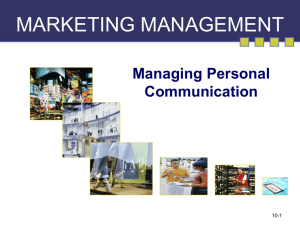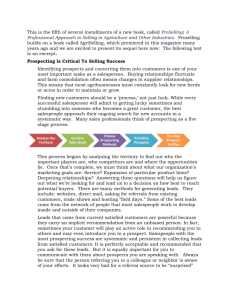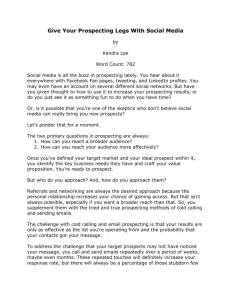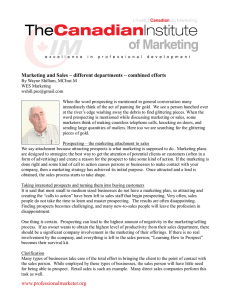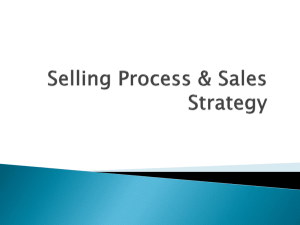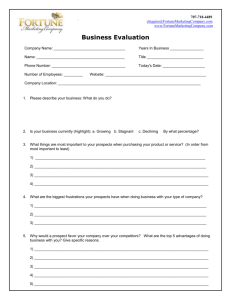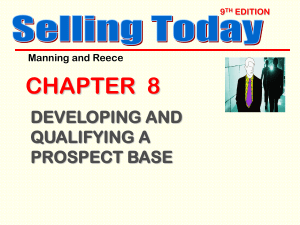Prospecting/Targeting
advertisement
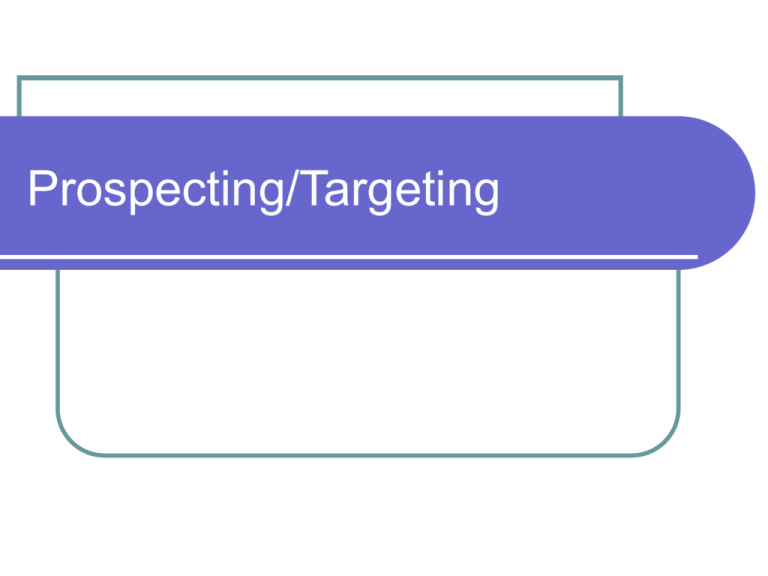
Prospecting/Targeting PROSPECTING Is the process of finding or locating high potential customers (i.e. prospects). Starting from Scratch? After graduating from college, Ryan recently took an entry-level sales position with Agri Gold. The company has no customers currently in Ryan’s sixcounty trade territory. Ryan has been asked to build Agri Gold’s business in his assigned area. What advice do you have for Ryan on finding customers? Can I Lend You Some Money? John is an ag loan officer for a local bank in Sheffield. He currently serves about 50 farmer borrowers annually while trying to gain 5-10 new borrowers. Given not everybody ‘goes to the bank’ much these days, what recommendations do you have for John for identifying and contacting prospects? Why Are Sales Booming? Jeremy sells fertilizer for a local farm supply business in central Illinois. In his last four years, he has seen quantity sales increase 28% and he has been given two job promotions. What does Jeremy say has been the main key to his successful sales growth? Growing or Converting A Prospect? Scott works for a prominent Midwestern insurance company that focuses on meeting the insurance needs of small businesses. The company’s sales strategy includes the idea of a ‘cultivation loop’. What is being ‘cultivated’ and what are the steps involved? Prospecting In Reverse? Marv and Evelyn live in a neighborhood that has seen its share of residential basement water problems is a result of recent heavy rains. Their house is no exception. So far, they have only had minor ‘leakage’ problems, but they are concerned about possible, greater, long-term problems if they don’t deal with the matter soon. What should Marv and Evelyn do? Prospecting observations: Should be viewed as an opportunity to benefit someone vs. a chore (easier to spend time with established customers) Average customers attrition rate = 20-25%/yr because customers: 1. 2. 3. 4. Move Go out of business Retire Change positions Die Switch to a competitor Needs change Needs to be planned and scheduled (can’t rely on serendipity or luck to find new customers) Can’t neglect current customers in order to prospect Sources of Prospects/Prospecting Methods Cold calling → visit or call people for whom you have no information 1. Cool calling → visit or call people for whom you have some information (e.g. business type, business size) Referrals/leads → visit or call people who have been suggested to you by current customer, or someone else 2. 3. 4. 5. 6. 7. 8. 9. Scary Can open doors and penetrate areas where there are few sales currently Obtain permission Serves as a testimonial and builds credibility Directories (e.g. business, telephone) Trade shows/publications Promotion/marketing (e.g. letters, post cards, advertise, web site, phone calls) Networking → using contacts/connections to meet other people (e.g. within company, within industry, outside) Conducting meetings/seminars Miscellaneous (e.g. personal observations, social outings, traveling) A Full Day of Excuses for Not Calling on Prospects 8-10 a.m. People usually busy with meetings. 10-11 a.m. People tied up with projects mid morning. 11 a.m.-2 p.m. People going to, at, or coming back from LUNCH. 2-4 p.m. People busy with training, projects, and more meetings. 4-5 p.m. People busy wrapping up their day and heading home. Targeting or Qualifying Prospects Narrowing down the ‘list’ (i.e. can vs. should be contacted) Critical for time management (cost per prospect call = $200) Trying to sell to everybody is less effective than concentrating efforts High potential prospect is one who: Needs product/services Makes the purchase decision Is sufficiently large to be profitable to serve Is not a credit risk May already be buying some of your product Has convenient location Is vulnerable to making a change Has pricing philosophy consistent with yours Is not a frequent switcher Is influential in the market ‘Good’ Targets? Opinion Leaders = Good prospects = ‘Good’ farmers = ‘Good’ business managers Characteristics Early adopters Large sphere of influence (respected) Leaders Boards of directors School board Church Community organizations Commodity groups Cautious Expect salespeople to be knowledgeable & prepared Identifying Opinion Leaders Extension agents Bankers Vo-Ag instructors Farm suppliers Other farmers, business leaders Strategies for Selling to Opinion Leaders 1. 2. 3. Recognize their accomplishments Show them respect/seek their advice Form advisory board of opinion leaders 4. 5. Meet semi regularly Discuss issues, concerns, current events Build relationship with them Give them special attention (but no ‘special’ deals) Prospecting Quotes Professional sales reps discipline themselves to not sell until they find out who is buying what. The biggest rookie mistake is trying to sell everything to everybody. (Jack Falvey, WSJ, 12-23-91) The main purpose of a salesperson is not to make sales, but to create customers. (Selling Power) If selling were just a matter of determining who’s got the low bid, the world wouldn’t need salespeople.” (Howey MacKay) You can make more friends in two months by becoming interested in other people than you can in two years by trying to get other people interested in you. (Dale Carnegie)
